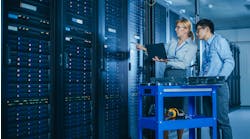Data Centers Play an Important Role as Leaders of Change
When they engage in video calls, stream movies, or browse social media, few realize that these actions are made possible by data centers.
Interconnected data center infrastructure enables every part of modern life. It allowed people to work from home during COVID, paving the way to hybrid working. It makes telemedicine and emergency services work and speeds up all types of research and development. For businesses, the huge volume of data stored and processed in data centers powers logistics, HR, finance and sales, with public cloud infrastructure and applications that are revolutionizing every sector from entertainment and gaming to government and banking.
Growing Digital Demand
This has led to continued growth in digital demand as more facets of our lives are influenced by technology. A lot of what was once physical is now digital and lives in data centers. An IDC report predicts that by 2026, organizations that successfully adopt a data-driven approach will generate more than 25% of their revenues from digital products, services or experiences.
Data levels will continue to grow and so will data centers. Current estimates are that 120 Zettabytes of data will be created, captured, copied and consumed this year, and this will grow by over 50% by 2025. While Power Usage Effectiveness (PUE) continues to improve as in-house equipment shifts to larger shared facilities, improvements will be smaller and overall power consumption will rise faster.
Working Toward a Sustainable Future
As the need for data centers grows, we must strive to reduce our environmental impact. Together, we must work to be part of the solution. In an era where the world is grappling with the urgent need to mitigate climate change, the data center industry has emerged as a key player in the race toward decarbonization.
As the demand for data storage and processing continues to skyrocket, we believe our role is to take the lead in adopting innovative solutions and sustainable practices that not only minimize their carbon footprint but also pave the way for a greener future.
The latest United Nations Intergovernmental Panel on Climate Change has made it clear that climate change is causing widespread disruption in every part of the world. The time has come for data centers to become beacons of environmental stewardship, showcasing how technology can coexist with our planet's delicate ecosystems.
More Efficient Data Centers
One key to handling this growth is to build more efficient data centers. The bigger and more specialized data centers have become, the more efficiently they have handled workloads. Over the last decade, legacy in-house data centers have migrated much of their IT workload to colocation or cloud facilities, massively improving operational efficiency. That efficiency has helped to offset the potential negative impact of the exponential growth in data.
Greening the Grid
Fortunately, much of the data center industry has already been working to green the grid, led to a great extent by the largest public cloud providers and innovators in the colocation sector. As well as being critical enablers of our digital society, data centers are now becoming critical enablers of decarbonization.
This begins with renewable energy. The world’s top four purchasers of clean energy are cloud service providers, and colocation providers feature strongly in the top 100. Renewables now account for over 30% of power generation. In 2023 data centers will account for a phenomenal two thirds of renewable power consumed by businesses in the USA. And this is not putting a squeeze on other would-be renewable power users or stealing power from others. The bulk of this is ‘additional’ power, generated by new wind, solar or geothermal projects via virtual power purchase agreements (VPPAs). ‘Additionality’ - growing the number of renewable facilities - is a key focus for VPPAs and has helped to speed up the overall greening of the world grid.
Virtual to Real
Data centers are nothing if not ambitious, and they are now aiming higher. Amazon is the world’s largest purchaser of renewables. Microsoft has committed to not only be carbon negative by 2030 but to erase its total carbon footprint going back to 1975 by 2050. Google has committed to go beyond Virtual Power Purchase Agreements (VPPAs) and run on 24x7 carbon-free power by 2030. Iron Mountain Data Centers, already running on 100% renewable power, was the first colocation provider to make the same commitment.
The key to using real rather than virtual renewable power - genuine decarbonization - is tracking, analysis and rerouting. There are advantages to being a relatively new sector. Because the data center industry is new, it can do things differently. And, like the rest of society, it can take advantage of these new data-driven technologies to power its own transformation.
Changes & Challenges
Not all data centers are green, even if many are well on their way. Data centers are not genuinely sustainable yet, and data processing and power consumption will continue to grow as society relies on digital infrastructure more and more. But data centers are definitely changing the way we live. And many are also doing their best to tackle the challenges of the climate crisis.
We all play an important role in decarbonizing the grid. Together, we can become part of the solution to some of the world’s biggest environmental challenges and create a more sustainable future.
Mark Kidd is the executive vice president and general manager of the Iron Mountain Data Centers and Asset Lifecycle Management (ALM) business units. Mark has led the data center organization since its inception in 2013 and additionally took over the ALM organization in early 2023. Mark is responsible for driving growth across the data centers and ALM platforms, including setting strategic direction, leading commercial efforts, and developing expansion opportunities.






